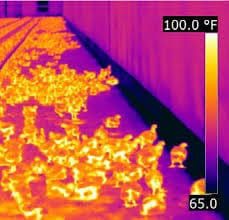
Winter ventilation comes with a unique set of challenges. Incoming air is cold and dry, heaters seem like they are always running, and the cost of fuel is only going up.
Attic inlets are sometimes used to minimize the use of heaters. The idea is that the sun would warm the attic air, which would then be pulled into the bird area and used as a heat source in lieu of gas or propane. The theory can work, but careful management must be taken to ensure some of these common problems don’t arise:
- Drafting cold air onto birds
- If attic inlets are run at too high or low a static pressure, and the attic air temperature is too far below the target temperature, the air will fall too quickly from the ceiling and side walls. This rapid descent doesn’t allow enough time for the air to mix adequately, and results in cold air falling onto the birds.
- Potential leakage between attic and bird area
- Care must be taken to ensure that the inlets don’t get stuck open or in the “not quite closed” position. Additionally, if the inlets open before the fans come on, they allow warm moist air to flow into the cooler attic during the min vent cycle. Both of these result in condensation on the barn ceiling and inlet opening, which can in turn ruin attic insulation and impact barn structural integrity over time. Not to mention the resulting heat loss and increased heater run times (completing defeating the use of attic inlets).
 To get the best performance from the use of attic inlets, consider the following:
To get the best performance from the use of attic inlets, consider the following:
- Only use attic air when it is within 10-15 degrees of the house target temperature.
- Keep static pressure consistent – around 0.08” – 0.10” (less in narrower houses)– to get adequate air mixing higher in the house.
- Make sure inlets close and seal properly when not in use.
Ready to take it even further? The whole point of controlling air flow with static pressure is to create even distribution, mixing, and temperature. The Hemisphere Mixing Fan does all of that for the best flock performance possible.
Subscribe to our blog!
